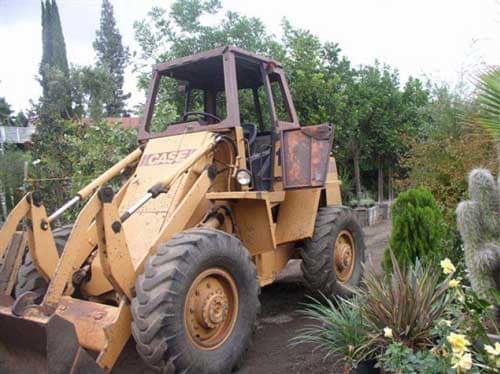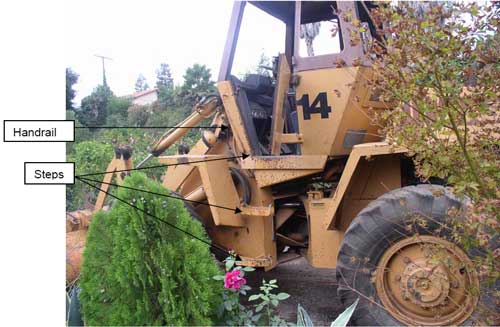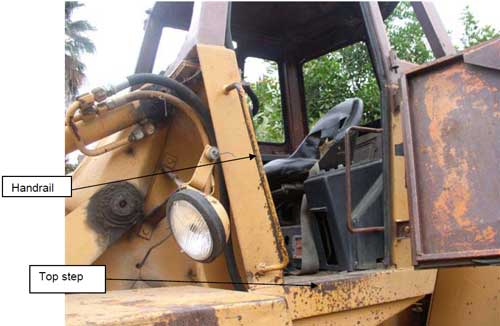A Horticulture Nursery Owner Dies When He Slips and Falls off a Tractor
California Case Report: 10CA007
Summary
A horticulture wholesale nursery owner died when he slipped and fell off a tractor he was loading onto a trailer. The victim had driven the tractor up on the trailer and was climbing out of the cab of the tractor when he slipped and fell approximately eight feet to the asphalt ground below. The victim was wearing western style boots with smooth soles when the incident occurred. The CA/FACE investigator determined that, in order to prevent future occurrences, employers of horticultural nursery workers should:
- Provide employees with proper skid or slip resistant protective footwear.
Introduction
On August 27, 2010, at approximately 2:00 p.m., a 60-year-old Hispanic horticulture wholesale nursery owner died when he slipped and fell off a tractor that he was loading onto a trailer. The CA/FACE investigator was notified of this incident on September 3, 2010, by the Los Angeles County Coroner’s post mortem reports. On September 23, 2010, the CA/FACE investigator interviewed three former employees of the victim’s company, who worked at the landscaping nursery where the tractor was stored. On October 6, 2011, the CA/FACE investigator interviewed the brother of the victim, who was helping him load the tractor onto the trailer when the incident occurred.
The victim was the owner of a horticulture wholesale nursery business specializing in garden flowers, landscaping trees, evergreen shrubbery, and grass. The company had been in business for 26 years and previously had over 50 employees at six locations throughout Southern California. At the time of the incident, the victim’s company was going out of business and the victim was in the process of liquidating all of the company assets. There were only three workers employed by the company.
The victim was born in Mexico and had lived in the United States for the past 40 years. He had a sixth grade education and spoke both English and Spanish. According to the victim’s brother, the company had a written Injury and Illness Prevention Program (IIPP) but because the company had gone out of business, he was unable to retrieve a copy of the document for review. He also stated that the training for employees was mostly accomplished though on-the job training (OJT).
Investigation
At approximately 2 p.m. on the day of the incident, the victim and his brother were retrieving an articulating front end loader tractor that was stored at another nursery. The weather was clear without rain. The victim climbed into the cab of the tractor and drove it to the rear of the nursery where a truck and trailer were parked. The victim drove the tractor onto the trailer, guided by his brother’s signals. After positioning the tractor on the trailer, the brother of the victim went to get chains to tie the tractor to the trailer. Evidence suggests that the victim shut off the engine of the tractor, got out of the seat, turned backwards to descend the stairs on the outside of the tractor’s cab, and during his descent slipped and fell backwards onto the asphalt ground approximately 8 feet below.
When the victim’s brother returned with the chains, he found the victim lying on the ground bleeding and semi-conscious. He immediately called 911. The fire department and paramedics transported the victim to a local hospital where he died later that evening from his injuries. According to his brother, the victim was wearing western style cowboy boots on the day of the incident.
Cause of Death
The cause of death according to the death certificate was blunt head trauma.
Recommendations/Discussion
Recommendation #1: Wear proper skid or slip resistant footwear when climbing onto or off of tractors.
Discussion: In this incident, the victim climbed down from the elevated tractor, which required him to place his foot on the steel steps attached to the tractor cab. This maneuver posed a risk of slipping, especially as it may be difficult to visually see these surfaces when climbing backwards. When the victim was exiting the tractor, the evidence suggests that his cowboy boots slipped off the steel steps and he fell to the ground below. When climbing off or onto a tractor, non-skid or non-slip resistant footwear should be worn to reduce the risk of slip and falls. A work shoe or boot should be selected based on the surface material, the tread design, and the contact area. Had the victim been wearing slip or skid resistant footwear, he may have had secure contact with the steel steps, thereby preventing his fall to the ground below.
Reference
California Code of Regulations, Subchapter 7, General Industry Safety Orders, Group 2. Safe Practices and Personal Protection Article 10. Personal Safety Devices and Safeguards §3385. Foot Protection.
Exhibits

|
 |
 |
|
Exhibit 3. The entrance to the cab of the tractor showing the top step and handrail.
|
California Fatality Assessment and Control Evaluation (FACE) Project
The California Department of Public Health, in cooperation with the Public Health Institute and the National Institute for Occupational Safety and Health (NIOSH), conducts investigations of work-related fatalities. The goal of the CA/FACE program is to prevent fatal work injuries. CA/FACE aims to achieve this goal by studying the work environment, the worker, the task the worker was performing, the tools the worker was using, the energy exchange resulting in fatal injury, and the role of management in controlling how these factors interact. NIOSH-funded, State-based FACE programs include: California, Iowa, Kentucky, Massachusetts, Michigan, New Jersey, New York, Oregon, and Washington.
To contact California State FACE program personnel regarding State-based FACE reports, please use information listed on the Contact Sheet on the NIOSH FACE web site. Please contact In-house FACE program personnel regarding In-house FACE reports and to gain California Case Reports
